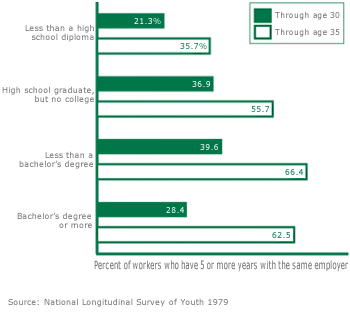|
The U.S. Departments of Labor and
Education have teamed up to offer free career resources
through a Web site, Career Voyages. Career Voyages offers
information for  career
exploration in several industries, including
biotechnology,
construction, geospatial technology, healthcare,
information technology, and transportation. career
exploration in several industries, including
biotechnology,
construction, geospatial technology, healthcare,
information technology, and transportation.
Each industry profile provides
information about education and training options—from
registered apprenticeship to 4-year college—and includes
brief career videos about occupations within the industry.
The site tailors its content to various audiences:
Students, parents, career changers, and career advisors.
Visit Career Voyages online at www.careervoyages.gov.
Much of its content is also available offline by calling
toll-free, 1 (877) US-2 JOBS (872-5627).
 Top Top
|
|
Health and safety on the job are important to
all workers. But because of their youth and inexperience,
teenage workers sometimes put themselves more at risk for
workplace injuries.
To help keep teen workers healthy and safe, the
U.S. Department of Labor’s Occupational Safety and Health
Administration (OSHA) provides information for these workers and
their parents, employers, and educators. A  free
brochure lists employers’ and teen workers’
responsibilities, tips for ways in which teens can protect
themselves on the job, and common workplace hazards and
injuries. free
brochure lists employers’ and teen workers’
responsibilities, tips for ways in which teens can protect
themselves on the job, and common workplace hazards and
injuries.
The brochure also highlights an OSHA Web site
that expands on the topic of teen workers’ safety and health.
This online resource includes links to an e-tool for restaurant
workers’ safety and a State-by-State breakdown of child labor
laws. "Real Stories," taken from OSHA inspection data,
serve as strong warnings by relaying job-related accidents that
involved teens.
To receive up to five free copies of Brochure
3244 on teen workers, write to the U.S. Department of Labor/OSHA,
OSHA Publications, P.O. Box 37535, Washington, DC 20013-7535;
call (202) 693-1888; or fax (202) 693-2498.
For more information, call OSHA toll-free, 1 (800) 321-OSHA (321-6742), or visit its online
resource for teen workers, www.osha.gov/teens.
 Top Top
|
|
|
|
|
|
|
|
For some people, where to go to college is less
of a concern than how to pay for it. The College Board can help
ease these worries.
The College Board, a nonprofit membership
association, is perhaps best known for its college-entrance and
advanced-placement examinations. But it also provides guidance
related to higher education, including information  about
college financing. Online, the board offers scholarship
searches, college financing calculators, and other financial aid
tools. It also has links to dozens of articles on a variety of
topics, including where to find scholarships, how the borrowing
process works, and myths about financial aid. Much of this
information about
college financing. Online, the board offers scholarship
searches, college financing calculators, and other financial aid
tools. It also has links to dozens of articles on a variety of
topics, including where to find scholarships, how the borrowing
process works, and myths about financial aid. Much of this
information
also is available offline.
You can get the information by contacting The
College Board, 45 Columbus Avenue, New York, NY 10023-6992;
(212) 713-8000. You may also visit the college-financing portion of the board’s Web site at
www.collegeboard.com/pay.
 Top Top
|
|
|
|
|
|
|
|
|
|
|
Are you patient and dependable? Do you have good
eye-hand coordination, enjoy precision, and have mechanical and
mathematical abilities? Are you interested in entering an
occupation that is projected to grow faster than the average?
If you answered yes to these questions, you
might want to consider a career as a professional locksmith.
Locksmiths install and repair locks and other devices to
safeguard  homes,
businesses, and property. They also make duplicate keys,
generate new keys to replace lost ones, and respond to emergency
calls to open doors that have been locked accidentally. homes,
businesses, and property. They also make duplicate keys,
generate new keys to replace lost ones, and respond to emergency
calls to open doors that have been locked accidentally.
Recommended classes for interested high
schoolers include mathematics, mechanical drawing, physics, and
electronics. On-the-job training, which may involve coursework
at a school for locksmiths, is the usual method of entry into
the occupation.
According to the U.S. Bureau of Labor Statistics
(BLS), job growth for locksmiths and safe repairers is expected
to be faster than the average for all occupations between 2002
and 2012. BLS data also show that about 15,500 locksmiths were
employed in May 2004, with median earnings of $30,360. However,
those data are for wage-and-salary workers. Self-employed
locksmiths are not included, and many locksmiths are
self-employed.
To learn more about the occupation, such as training and
scholarship information, write to the Associated Locksmiths of
America, 3500 Easy Street, Dallas, TX 75247; call 1 (800)
532-2562 (toll-free) or (214) 827-1701; or visit online at www.aloa.org.
 Top Top
|
|
|
|
|
|
Not all questions have immediate
answers. That’s why some BLS surveys ask the same
questions of the same people many times. These kinds
of studies, called longitudinal surveys, can show how
people’s careers evolve throughout their lives. And
one BLS longitudinal survey has been studying
workforce issues for a quarter century.
In 1979, BLS began surveying a group
of young people aged 14 to 21 about their employment,
education, and other facts. The National Longitudinal
Survey of Youth 1979 has tracked changes in the lives
of people in this group as they moved from young
adulthood to middle age. BLS researchers have
interviewed this same group of people more than 20
times over the years, allowing researchers to study
the effects of education and training on income and
employment. Questions about labor force and education
are the focus of the study. But questions also cover a
myriad of other issues, such as health, income, family
size, marital status, and childcare.

Some of the latest results from this
survey indicate that workers’ education levels
affect the length of time they stay with an employer,
at least early in their careers. The chart shows, by
level of workers’ educational attainment,
the
percent of workers who had been with one employer for
5 years or more from the time they left school until
the time they reached ages 30 and 35. The percent of
workers who had long employment relationships
increased with education, except in the cases of
workers who have a bachelor’s or higher degree.
For information about the National Longitudinal
Survey of Youth 1979, see the February 2005 special
issue of the Monthly Labor Review (online at www.bls.gov/opub/mlr/2005/02/contents.htm)
or contact BLS NLSY79, 2 Massachusetts Avenue NE.,
Room 4945, Washington, DC 20212-0001; (202) 691-7410.
The program’s Web site is www.bls.gov/nls.
 Top Top
|
|
|



